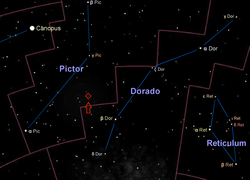HD 40307
| Observation data Epoch J2000.0 Equinox J2000.0 (ICRS) |
|
|---|---|
| Constellation | Pictor |
| Right ascension | 05h 54m 04.2409s |
| Declination | −60° 01′ 24.498″ |
| Apparent magnitude (V) | 7.17 |
| Characteristics | |
| Spectral type | K2.5V |
| B−V color index | 0.93 |
| Astrometry | |
| Radial velocity (Rv) | +30.4 ± 0.2 km/s |
| Proper motion (μ) |
RA: −51.76 mas/yr Dec.: −60.44 mas/yr |
| Parallax (π) | 77.95 ± 0.53mas |
| Distance | 41.8 ± 0.3 ly (12.83 ± 0.09 pc) |
| Absolute magnitude (MV) | 6.57 |
| Details | |
| Mass | 0.75+0.03 −0.04 M☉ |
| Radius | 0.716 ± 0.010 R☉ |
| Luminosity (bolometric) | 0.23 L☉ |
| Luminosity (visual, LV) | 0.19 L☉ |
| Surface gravity (log g) | 4.47 ± 0.16 cgs |
| Temperature | 4977 ± 59 K |
| Metallicity [Fe/H] | −0.31 ± 0.03 dex |
| Rotation | 31.8±6.7 d |
| Rotational velocity (v sin i) | 3 km/s |
| Age | 1.2 (≥ 0.2) Gyr |
| Other designations | |
| Database references | |
| SIMBAD | data |
| Exoplanet Archive | data |
| ARICNS | data |
| Extrasolar Planets Encyclopaedia |
data |
HD 40307 is an orange (K-type) main-sequence star located approximately 42 light-years away in the constellation of Pictor (the Easel), taking its primary name from its Henry Draper Catalogue designation. It is calculated to be slightly less massive than the Sun. HD 40307 was observed during or before 1900 as part of the Cape Photographic Durchmusterung. The star has six known planets, three discovered in 2008 and three more in 2012. One of them, HD 40307 g, is a potential super-Earth in the habitable zone, with an orbital period of about 200 days. This object might be capable of supporting liquid water on its surface, although much more information must be acquired before its habitability can be assessed.
The designation HD 40307 is from the Henry Draper Catalogue, which is based on spectral classifications made between 1911 and 1915 by Annie Jump Cannon and her co-workers, and was published between 1918 and 1924.
As a K-type star, HD 40307 emits orange-tinted light. It has only about three-quarters of the Sun's radius and mass. Its temperature is measured at slightly under 5000 K. This is relatively high for a K-type star, approaching the temperatures normally found in G-type stars such as the Sun.
The astronomers who discovered the planets orbiting HD 40307 suggested that the metallicities of stars determine whether or not the planetary bodies that orbit them will be terrestrial, like Earth, or gaseous, like Jupiter and Saturn.
...
Wikipedia

